
Fish locomotion is the variety of types of animal locomotion used by fish, principally by swimming. This however is achieved in different groups of fish by a variety of mechanisms of propulsion in water, most often by wavelike movements of the fish's body and tail, and in various specialised fish by movements of the fins. The major forms of locomotion in fish are anguilliform, in which a wave passes evenly along a long slender body; sub-carangiform, in which the wave increases quickly in amplitude towards the tail; carangiform, in which the wave is concentrated near the tail, which oscillates rapidly; thunniform, rapid swimming with a large powerful crescent-shaped tail; and ostraciiform, with almost no oscillation except of the tail fin. More specialised fish include movement by pectoral fins with a mainly stiff body, as in the sunfish; and movement by propagating a wave along the long fins with a motionless body in fish with electric organs such as the knifefish.
Central pattern generators (CPGs) are biological neural circuits that produce rhythmic outputs in the absence of rhythmic input. They are the source of the tightly-coupled patterns of neural activity that drive rhythmic and stereotyped motor behaviors like walking, swimming, flying, ejaculating, urinating, defecating, breathing, or chewing. The ability to function without input from higher brain areas still requires modulatory inputs, and their outputs are not fixed. Flexibility in response to sensory input is a fundamental quality of CPG-driven behavior. To be classified as a rhythmic generator, a CPG requires:
- "two or more processes that interact such that each process sequentially increases and decreases, and
- that, as a result of this interaction, the system repeatedly returns to its starting condition."
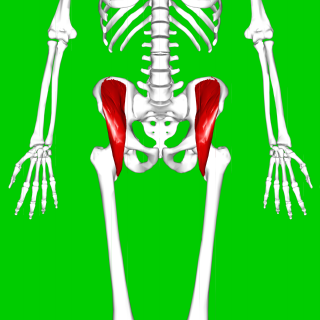
The iliacus is a flat, triangular muscle which fills the iliac fossa. It forms the lateral portion of iliopsoas, providing flexion of the thigh and lower limb at the acetabulofemoral joint.
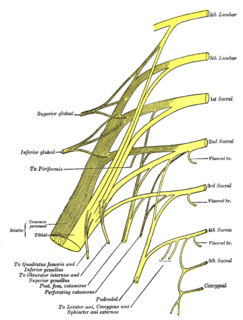
The superior gluteal nerve is a nerve that originates in the pelvis and supplies the gluteus medius, the gluteus minimus, the tensor fasciae latae and the piriformis muscles.
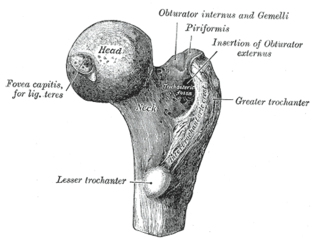
The intertrochanteric crest is a bony ridge located on the posterior side of the head of the femur, stretching obliquely downward and medially from the summit of the greater trochanter to the lesser trochanter.

The iliofemoral ligament is a ligament of the hip joint which extends from the ilium to the femur in front of the joint. It is also referred to as the Y-ligament. the ligament of Bigelow, the ligament of Bertin and any combinations of these names.

8-Chlorotheophylline, also known as 1,3-dimethyl-8-chloroxanthine, is a stimulant drug of the xanthine chemical class, with physiological effects similar to caffeine. Its main use is in combination (salt) with diphenhydramine in the antiemetic dimenhydrinate. Diphenhydramine reduces nausea but causes drowsiness, and the stimulant properties of 8-Chlorotheophylline help ward off that side-effect.
Shepherd Center is a private, not-for profit hospital in Atlanta, Georgia. Founded in 1975, the 152-bed hospital focuses on the medical treatment, research and rehabilitation for people with spinal cord injury and disease, acquired brain injury, multiple sclerosis, chronic pain and other neuromuscular problems.

Hypericum maculatum, commonly known as imperforate St John's-wort, or spotted St. Johnswort, is a species of perennial herbaceous flowering plant in the family Hypericaceae. It is native to Europe and Western Asia where it grows in moist meadows.

Certain species of fish and birds are able to locomote in both air and water, two fluid media with very different properties. A fluid is a particular phase of matter that deforms under shear stresses and includes any type of liquid or gas. Because fluids are easily deformable and move in response to applied forces, efficiently locomoting in a fluid medium presents unique challenges. Specific morphological characteristics are therefore required in animal species that primarily depend on fluidic locomotion. Because the properties of air and water are so different, swimming and flying have very disparate morphological requirements. As a result, despite the large diversity of animals that are capable of flight or swimming, only a limited number of these species have mastered the ability to both fly and swim. These species demonstrate distinct morphological and behavioral tradeoffs associated with transitioning from air to water and water to air.
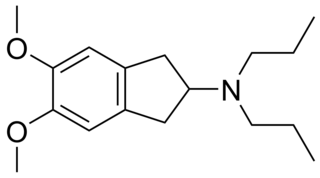
PNU-99,194(A) (or U-99,194(A)) is a drug which acts as a moderately selective D3 receptor antagonist with ~15-30-fold preference for D3 over the D2 subtype. Though it has substantially greater preference for D3 over D2, the latter receptor does still play some role in its effects, as evidenced by the fact that PNU-99,194 weakly stimulates both prolactin secretion and striatal dopamine synthesis, actions it does not share with the more selective (100-fold) D3 receptor antagonists S-14,297 and GR-103,691.

The pisiform joint is a joint between the pisiform and triquetrum.

Boccia at the 2012 Summer Paralympics was held in the ExCeL from 2 September to 8 September, with a maximum of 104 athletes competing in seven events. There were four individual events, two pair events, and one team event.

Cycling has been contested at every Summer Paralympic Games since the 1984 Summer Paralympics.

The 2011 UCI Para-cycling Track World Championships were the World Championships for track cycling where athletes with a physical disability competed in 2011. The Championships took place at the Montichiari Velodrome in Montichiari, Italy from 11 to 13 March 2011.

AC927 or 1-(2-phenylethyl)piperidine is a selective sigma receptor antagonist, with reported binding affinity of Ki = 30 ± 2 nM for the sigma-1 receptor and Ki = 138 ± 18 nM for the sigma-2 receptor, and negligible binding affinity for other major central nervous system receptors, transporters, and ion channels.

Boccia at the 2016 Summer Paralympics was held in Riocentro, in the Barra district of Rio de Janeiro in September 2016, with a maximum of 104 athletes competing in seven events. The programme consisted of four individual events, two pairs events, and one team event, spread across four classifications.
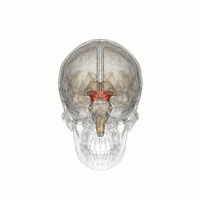
The mesencephalic locomotor region (MLR) is a functionally defined area of the midbrain that is associated with the initiation and control of locomotor movements in vertebrate species.
The 2017 UCI Para-cycling Road World Championships is the World Championships for road cycling for athletes with a physical disability. The Championships took place on the roads of Pietermaritzburg in South Africa from 31 August to 3 September 2017.















